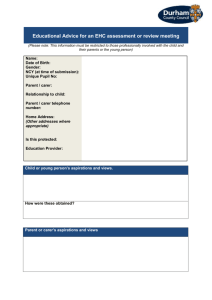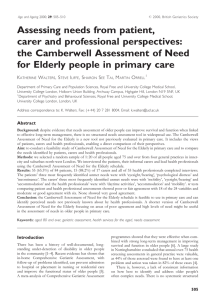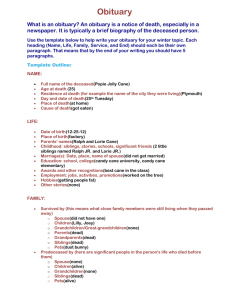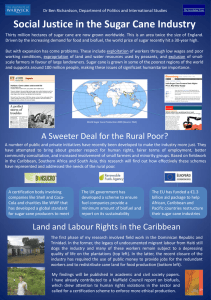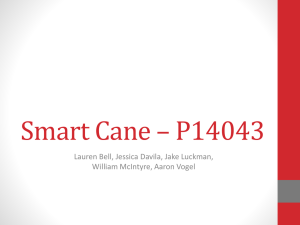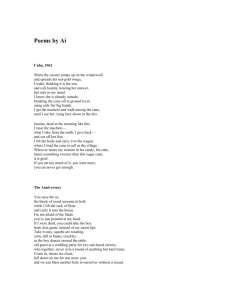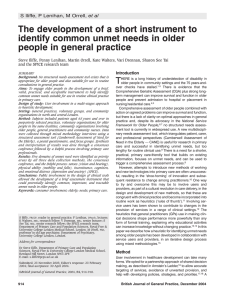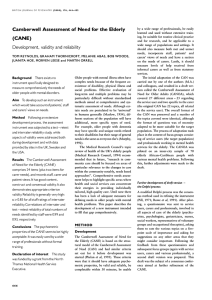Assessment of need EDITORIAL
advertisement
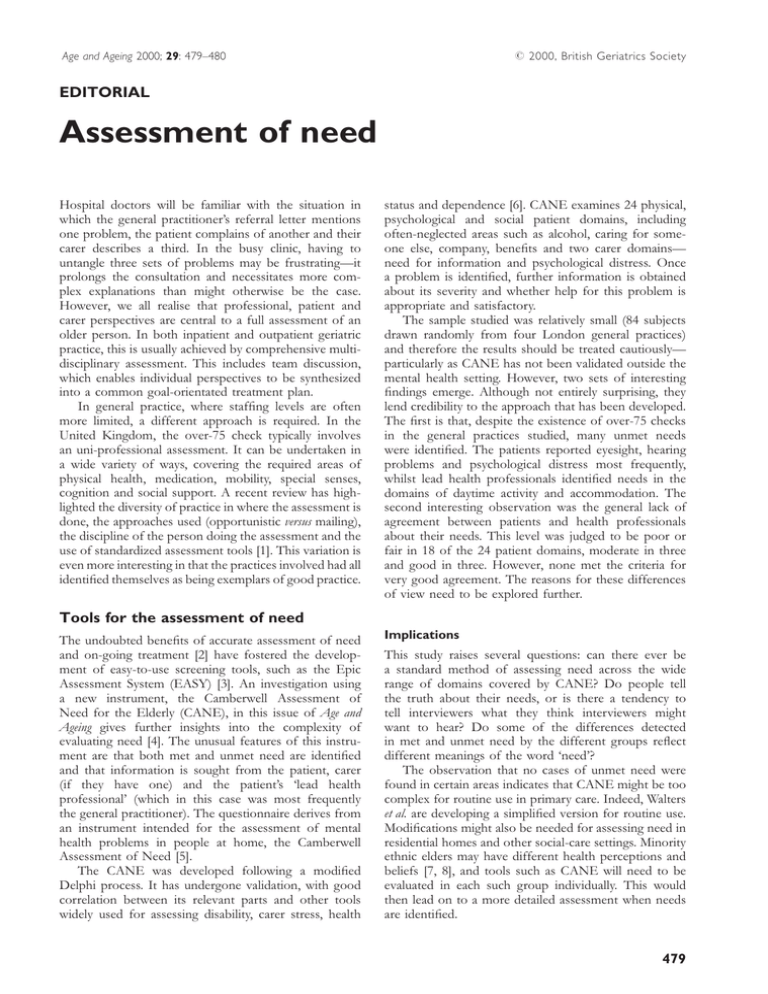
Age and Ageing 2000; 29: 479±480 # 2000, British Geriatrics Society EDITORIAL Assessment of need Hospital doctors will be familiar with the situation in which the general practitioner's referral letter mentions one problem, the patient complains of another and their carer describes a third. In the busy clinic, having to untangle three sets of problems may be frustratingÐit prolongs the consultation and necessitates more complex explanations than might otherwise be the case. However, we all realise that professional, patient and carer perspectives are central to a full assessment of an older person. In both inpatient and outpatient geriatric practice, this is usually achieved by comprehensive multidisciplinary assessment. This includes team discussion, which enables individual perspectives to be synthesized into a common goal-orientated treatment plan. In general practice, where staf®ng levels are often more limited, a different approach is required. In the United Kingdom, the over-75 check typically involves an uni-professional assessment. It can be undertaken in a wide variety of ways, covering the required areas of physical health, medication, mobility, special senses, cognition and social support. A recent review has highlighted the diversity of practice in where the assessment is done, the approaches used (opportunistic versus mailing), the discipline of the person doing the assessment and the use of standardized assessment tools [1]. This variation is even more interesting in that the practices involved had all identi®ed themselves as being exemplars of good practice. Tools for the assessment of need The undoubted bene®ts of accurate assessment of need and on-going treatment [2] have fostered the development of easy-to-use screening tools, such as the Epic Assessment System (EASY) [3]. An investigation using a new instrument, the Camberwell Assessment of Need for the Elderly (CANE), in this issue of Age and Ageing gives further insights into the complexity of evaluating need [4]. The unusual features of this instrument are that both met and unmet need are identi®ed and that information is sought from the patient, carer (if they have one) and the patient's `lead health professional' (which in this case was most frequently the general practitioner). The questionnaire derives from an instrument intended for the assessment of mental health problems in people at home, the Camberwell Assessment of Need [5]. The CANE was developed following a modi®ed Delphi process. It has undergone validation, with good correlation between its relevant parts and other tools widely used for assessing disability, carer stress, health status and dependence [6]. CANE examines 24 physical, psychological and social patient domains, including often-neglected areas such as alcohol, caring for someone else, company, bene®ts and two carer domainsÐ need for information and psychological distress. Once a problem is identi®ed, further information is obtained about its severity and whether help for this problem is appropriate and satisfactory. The sample studied was relatively small (84 subjects drawn randomly from four London general practices) and therefore the results should be treated cautiouslyÐ particularly as CANE has not been validated outside the mental health setting. However, two sets of interesting ®ndings emerge. Although not entirely surprising, they lend credibility to the approach that has been developed. The ®rst is that, despite the existence of over-75 checks in the general practices studied, many unmet needs were identi®ed. The patients reported eyesight, hearing problems and psychological distress most frequently, whilst lead health professionals identi®ed needs in the domains of daytime activity and accommodation. The second interesting observation was the general lack of agreement between patients and health professionals about their needs. This level was judged to be poor or fair in 18 of the 24 patient domains, moderate in three and good in three. However, none met the criteria for very good agreement. The reasons for these differences of view need to be explored further. Implications This study raises several questions: can there ever be a standard method of assessing need across the wide range of domains covered by CANE? Do people tell the truth about their needs, or is there a tendency to tell interviewers what they think interviewers might want to hear? Do some of the differences detected in met and unmet need by the different groups re¯ect different meanings of the word `need'? The observation that no cases of unmet need were found in certain areas indicates that CANE might be too complex for routine use in primary care. Indeed, Walters et al. are developing a simpli®ed version for routine use. Modi®cations might also be needed for assessing need in residential homes and other social-care settings. Minority ethnic elders may have different health perceptions and beliefs [7, 8], and tools such as CANE will need to be evaluated in each such group individually. This would then lead on to a more detailed assessment when needs are identi®ed. 479 P. Crome, C. Phillipson At the moment (in the UK at least) there appears to be a general reluctance to use a common standard instrument to assess need and it is unlikely that this attitude will change in the foreseeable future. The Government seems committed to developing a health service workforce trained to assess and improve the health and welfare of older people [9]. Integrating instruments such as CANE will be part of that process and may be of value in developing a consensus on needs assessment. The question, then, is how best to meet needs, thus realising for all the bene®ts that have been demonstrated in clinical trials. PETER CROME, CHRIS PHILLIPSON School of Postgraduate Medicine, University of Keele, Thornburrow Drive, Stoke-on-Trent, Staffordshire ST4 7QB, UK Fax: (q44) 1782 747 319 Email: peter.crome@nsch-tr.wmids.nhs.uk References 1. Iliffe S, Gould M, Wallace P. Assessment of older people in the community: lessons from Britain's `75-and-over checks'. Rev Clin Gerontol 1999; 9: 305±16. 480 2. Stuck AE, Siu LA, Wieland AG et al. Comprehensive geriatric assessment a meta-analysis of controlled trials. Lancet 1993; 342: 1032±6. 3. Philp I. Can a medical and social assessment be combined? J R Soc Med 1997; 90 (suppl. 32): 11±3. 4. Walters K, Iliffe S, See Tai S, Orrell M. Assessing needs from patient, carer and professional perspectives: the Camberwell Assessment of Need for Elderly people in primary care. Age Ageing 2000; 29: 505±10. 5. Phelan M, Slade M, Thornicroft G et al. The Camberwell Assessment of Need: the validity and reliability of an instrument to assess the needs of people with severe mental illness. Br J Psychiatry 1995: 167: 589±95. 6. Reynolds T, Thornicroft G, Abas M et al. Camberwell Assessment of Need for the Elderly (CANE): development, validity and reliability. Br J Psychiatry 2000; 176: 444±52. 7. Silveira E, Ebrahim S. Mental health and health status of elderly Bengalis and Somalis in London. Age Ageing 1995; 24: 474±80. 8. Shah A. The psychiatric needs of ethnic minority elders in the UK. Age Ageing 1998; 27: 267±9. 9. A Health Service of all the Talents. Developing the NHS Workforce. London: Department of Health, 2000.
